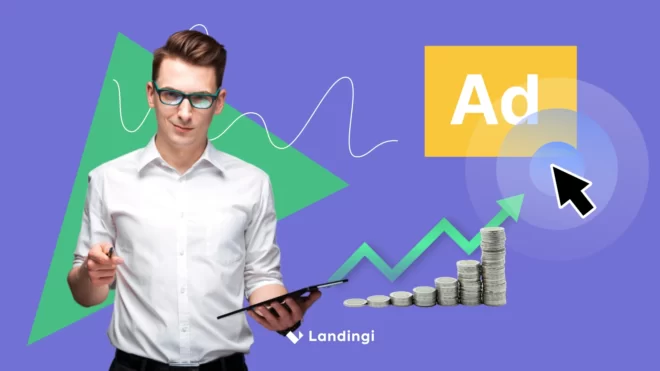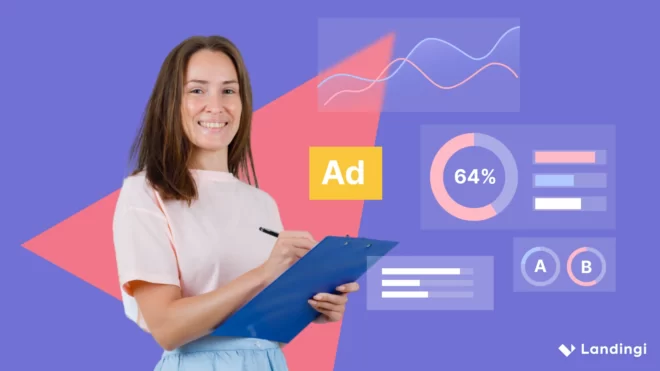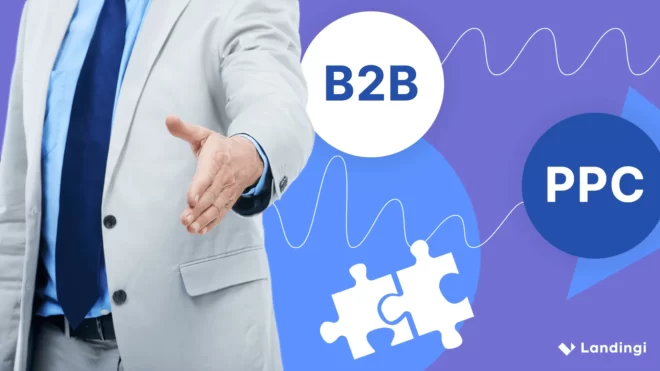Pay-per-click (PPC) advertising is a powerful tool for businesses in the economics sector to promote their services or products online. By targeting specific audiences, PPC campaigns drive high-quality traffic to websites and generate valuable leads. This article explores key strategies, practices, and best tools for successful PPC campaigns in economics – from ad platforms through analytics to the best tool for PPC landing pages in economics – Landingi.
Let’s go ahead!
Make your sections smartable and let go of mundane manual tasks with Smart Sections! An easy way to manage bulk changes.
What is PPC Advertising in Economics?
PPC advertising in economics involves creating and managing pay-per-click campaigns to promote services or products from this sector. These ads appear on search engines and various online platforms when users search for relevant terms. PPC campaigns allow businesses to reach their target audience effectively, driving traffic to their websites and generating leads or sales.
Who Should Use PPC in Economics?
PPC in economics should be used by businesses and organizations looking to effectively reach their target audience online. This includes economic consulting firms, financial institutions, educational institutions offering economics courses, publishers of economic research, and companies selling economic software or tools. By leveraging PPC advertising, these entities can attract potential clients, students, or customers actively searching for economic services or information, ensuring their marketing efforts are both efficient and effective.
What are the Benefits of using PPC Advertising for Economics?
The benefits of using PPC advertising for economics include increased visibility, targeted reach, measurable results, cost control, quick implementation, and flexibility for scaling up. PPC ads allow businesses in the economics sector to appear at the top of search engine results, making it easier for potential clients to find them.
- Increased Visibility: By appearing at the top of search results, PPC ads ensure that your business is seen by a larger audience. This heightened visibility can lead to more website visits and brand awareness.
- Targeted Reach: PPC campaigns can be tailored to specific keywords, demographics, and geographic locations. This precision targeting means your ads are shown to individuals who are most likely to be interested in your economic services or products.
- Measurable Results: PPC provides detailed analytics and reporting, allowing businesses to track important metrics such as click-through rates, conversion rates, and return on ad spend (ROAS). This data-driven approach enables continuous optimization and more efficient use of marketing budgets.
- Cost Control: PPC advertising allows for flexible budgeting. Businesses can set daily or monthly spending limits, ensuring they only pay when someone clicks on their ad. This cost control helps in maximizing the return on investment.
- Quick Implementation: Unlike some traditional marketing methods, PPC campaigns can be set up and launched quickly. This speed allows businesses to start attracting traffic and generating leads almost immediately.
- Flexibility and Scalability: PPC campaigns can be easily adjusted based on performance data. Businesses can scale up successful campaigns to reach a larger audience or refine their targeting strategies to improve results.
5 Key Strategies for Successful Economics PPC Campaigns
Key strategies for successful economics PPC campaigns include thorough keyword research, compelling ad copy, optimized landing pages, precise targeting, and regular performance monitoring. Let’s take a closer look at each one.
Thorough Keyword Research
Start with comprehensive keyword research to identify terms that your target audience is likely to use. Tools like Google Keyword Planner, SEMrush, and Ahrefs can help find high-value keywords with a good balance of search volume and competition. Focus on both short-tail and long-tail keywords to capture a wide range of search queries.
Compelling Ad Copy
Create clear and engaging ad copy that highlights the benefits of your services or products. Include strong calls to action that encourage users to click on your ad. Test different variations of headlines and descriptions to see what resonates best with your audience.
Optimized Landing Pages
Ensure your landing pages are relevant to the ad content and provide a seamless user experience. This includes having a clear headline, concise information, and an easy-to-use contact form. Make sure the landing pages are mobile-friendly and load quickly to prevent losing potential leads.
Precise Targeting
Use advanced targeting options to reach your ideal audience. This can include geographic targeting to focus on specific regions, demographic targeting to reach certain age groups or professions, and device targeting to optimize ads for mobile or desktop users. Utilize remarketing to re-engage visitors who have shown interest but did not convert initially.
Regular Performance Monitoring
Continuously monitor the performance of your PPC campaigns. Track key metrics like click-through rates, conversion rates, and cost per conversion to identify what’s working and what’s not. Use this data to make informed adjustments to your campaigns. A/B testing different ad copies and landing pages can also help optimize performance.
By implementing these strategies, businesses in the economics sector can create effective PPC campaigns that attract high-quality traffic, generate valuable leads, and achieve better return on investment.
How to Choose Effective Keywords for Economics PPC Campaigns
To choose effective keywords for your economics PPC campaigns, you must understand your audience, perfect in using digital marketing tools, know all the ins and outs about your competitors, and constantly monitor your ad campaigns’ outcomes. For more steps and more details take a look at the concise step-by-step guide below:
- Understand Your Audience: Identify the specific terms and phrases your target audience is likely to use when searching for economic services or products. Think about the problems they are trying to solve and the language they might use.
- Use Keyword Research Tools: Utilize tools like Google Keyword Planner, SEMrush, and Ahrefs to discover relevant keywords. These tools provide data on search volume, competition, and keyword suggestions. Look for keywords with high search volume and low to medium competition.
- Focus on Long-Tail Keywords: Long-tail keywords are longer, more specific phrases that potential clients might use. These keywords often have lower competition and higher conversion rates because they target users who are further along in the buying process. For example, instead of “economic consultant,” consider “affordable economic consultant for small businesses.”
- Analyze Competitor Keywords: Research the keywords your competitors are bidding on. Tools like SpyFu can help you see which keywords are driving traffic to their websites. This can give you ideas for additional keywords to target.
- Group Keywords into Themes: Organize your keywords into tightly related ad groups. Each ad group should focus on a specific theme or service. This helps improve the relevance of your ads and landing pages, leading to higher Quality Scores and better performance.
- Use Negative Keywords: Identify negative keywords to prevent your ads from showing up for irrelevant searches. For example, if you offer paid economic consulting services, you might want to exclude keywords like “free economic advice.” Regularly update your negative keyword list to improve ad relevance and reduce wasted spend.
- Monitor and Adjust: Continuously monitor the performance of your keywords. Use metrics like click-through rate (CTR), conversion rate, and cost per conversion to identify high-performing and underperforming keywords. Adjust your keyword strategy based on this data to optimize your campaigns.
Choosing the Best Ad Formats for Economics PPC
Choosing the best ad formats for economics PPC campaigns involves understanding the different types of ads available and selecting those that best fit your goals and target audience. Here are some effective ad formats to consider:
Search Ads: These are text-based ads that appear at the top of search engine results pages (SERPs) when users search for relevant keywords. Search ads are ideal for targeting users actively looking for economic services or products. They are highly effective for capturing high-intent traffic.
- Example: An economic consulting firm could use search ads with the headline “Top Economic Consulting Services” and the description “Expert economic analysis and strategies to grow your business. Contact us today for a free consultation”.
Display Ads: Display ads are visual ads that appear on various websites within the Google Display Network. They can include images, banners, and videos. Display ads are excellent for building brand awareness and reaching a broader audience. They are particularly useful for retargeting campaigns to re-engage users who have previously visited your website.
- Example: A publisher of economic research could use display ads with an eye-catching image of their latest report cover and the message “Download the Latest Economic Research Report – Free Access”.
Video Ads: Video ads are engaging and can be used to explain complex economic concepts, showcase client testimonials, or demonstrate the benefits of your services. Platforms like YouTube offer extensive reach and targeting capabilities. Video ads are effective for capturing attention and building trust with potential clients.
- Example: An online course provider could use a video ad featuring a professor explaining the benefits of their economics course, with testimonials from past students and a call to action to enroll now.
Local Service Ads (LSAs): LSAs are designed for service-based businesses. These ads appear at the top of Google search results and include business information such as contact details and customer reviews. LSAs help local economic firms connect with potential clients in their area.
- Example: A tax advisory company in Austin, Texas, could set up Local Service Ads to appear when users search for “emergency tax consultation in Austin” or “Austin tax advisory services”. The ad might feature the business name, phone number, and reviews. When users click on the ad, they can either call directly or send a message to the lawyer or advisor, enabling quick and direct communication.
Call-Only Ads: Call-only ads are specifically designed to encourage users to call your business directly. These ads are ideal for mobile users and can be particularly effective for services that require direct consultation. Call-only ads feature a prominent call button, making it easy for potential clients to contact you.
- Example: A consumer loan agency in Chicago could use call-only ads for urgent care, appearing when someone searches for “fast loans in cash in Chicago”. The ad would feature a “Call Now” button and text stating, “Immediate Loan Services with Minimum Procedures. Call Us Now.” This setup helps people seeking urgent loan services connect quickly with the company.
Responsive Search Ads: Responsive search ads allow you to provide multiple headlines and descriptions, which Google then tests to determine the most effective combinations. This ad format can improve your ad performance by automatically optimizing the best-performing ad copy based on user behavior.
- Example: A financial institution offering economic analysis tools could use responsive search ads with various headlines like “Advanced Economic Analysis Tools” and “Improve Your Economic Strategies,” along with descriptions like “Get real-time data insights” and “Trusted by top economists”.
Choosing the right ad formats for your economics PPC campaigns depends on your specific goals and target audience. By using a mix of these ad formats, you can increase your chances of reaching and engaging potential clients effectively.
How to Manage PPC Campaigns in Economics?
Managing PPC campaigns in economics involves understanding your audience, selecting relevant keywords, setting a budget, and continuously optimizing your campaigns.
- Begin by defining your target audience, such as students, educators, and professionals, and gather demographic data using tools like Google Analytics.
- Conduct thorough keyword research using tools like Google Keyword Planner to identify high-performing, long-tail keywords. Set a realistic budget based on the average cost-per-click for your chosen keywords, balancing cost and reach.
- Craft compelling ad copy that highlights your unique selling points and includes strong CTAs like “Learn More.” Ensure your landing page is optimized for conversions with clear headlines, relevant content, and a strong CTA, while being fast-loading and mobile-friendly.
- Monitor and adjust your campaigns continuously. Use analytics tools to track metrics such as click-through rate and conversion rate, and make data-driven adjustments. Incorporate negative keywords to filter out irrelevant clicks and use ad extensions to enhance your ad visibility.
By following these steps, you can effectively manage PPC campaigns in economics, attracting the right audience and maximizing your ROI.
Get 111 Landing Page Examples—The Ultimate Guide for FREE
What are Best Tools for PPC Economics Campaigns?
The best tools for PPC economics campaigns comprise ad platforms offered by Google, Bing, Facebook, etc., and a range of specific tools for keyword research, tracking the competitors, and checking performance (SEMrush, WordStream and Ahrefs are best ones).
Google Ads
- Dominant platform for PPC advertising
- Extensive reach across Google search and partner sites
- Robust targeting options including demographics, location, and behavior
Bing Ads
- Access to a different demographic of users not fully captured by Google
- Typically offers lower cost per click due to less competition
- Integrates with LinkedIn for enhanced B2B targeting options
Facebook Ads Manager
- Vast targeting capabilities including interests, behaviors, and detailed demographics
- Excellent for visual campaigns and retargeting with access to Facebook and Instagram users
- Advanced analytics and reporting features
SEMrush
- Provides comprehensive keyword research and competitive analysis
- Helps optimize ad campaigns and improve SEO alongside PPC efforts
- Features ad builder tools to craft compelling ad texts based on competitive data
WordStream
- Streamlines management of Google, Bing, and Facebook ads in one platform
- Offers suggestions and automated help to improve campaign performance
- Includes tools for keyword research, performance reporting, and workflow management
Ahrefs
- Strong tool for competitor analysis and keyword tracking
- Helps understand the PPC landscape in your niche by revealing competitor ad spend and targeting strategies
- Useful for tracking ad placement and effectiveness over time
Each of these tools offers unique features that can help optimize PPC campaigns for better performance, targeting, and ROI.
How Frequently Should you Optimize Your PPC Economics Campaigns?
You should optimize your PPC economics campaigns on a continuous basis, ideally performing reviews and adjustments weekly. Regular optimization ensures that your campaigns remain effective and responsive to changing market conditions and user behavior.
Weekly reviews allow you to monitor key metrics such as click-through rates (CTR), conversion rates, and cost per conversion. This frequent analysis helps identify underperforming keywords, ads, and landing pages, allowing for timely adjustments.
Additionally, monthly in-depth analysis is essential to assess broader trends and make strategic changes. This might include revisiting keyword strategies, bid adjustments, or re-evaluating your target audience.
4 Examples of PPC Campaigns in Economics
It’s time to explore a set of real examples of PPC in economics to learn how the theory introduced above works in practice.
#1 Yieldstreet
If you are searching in Google for investment opportunities in Massachusets, you’ll probably see a kind of this picture in Google:
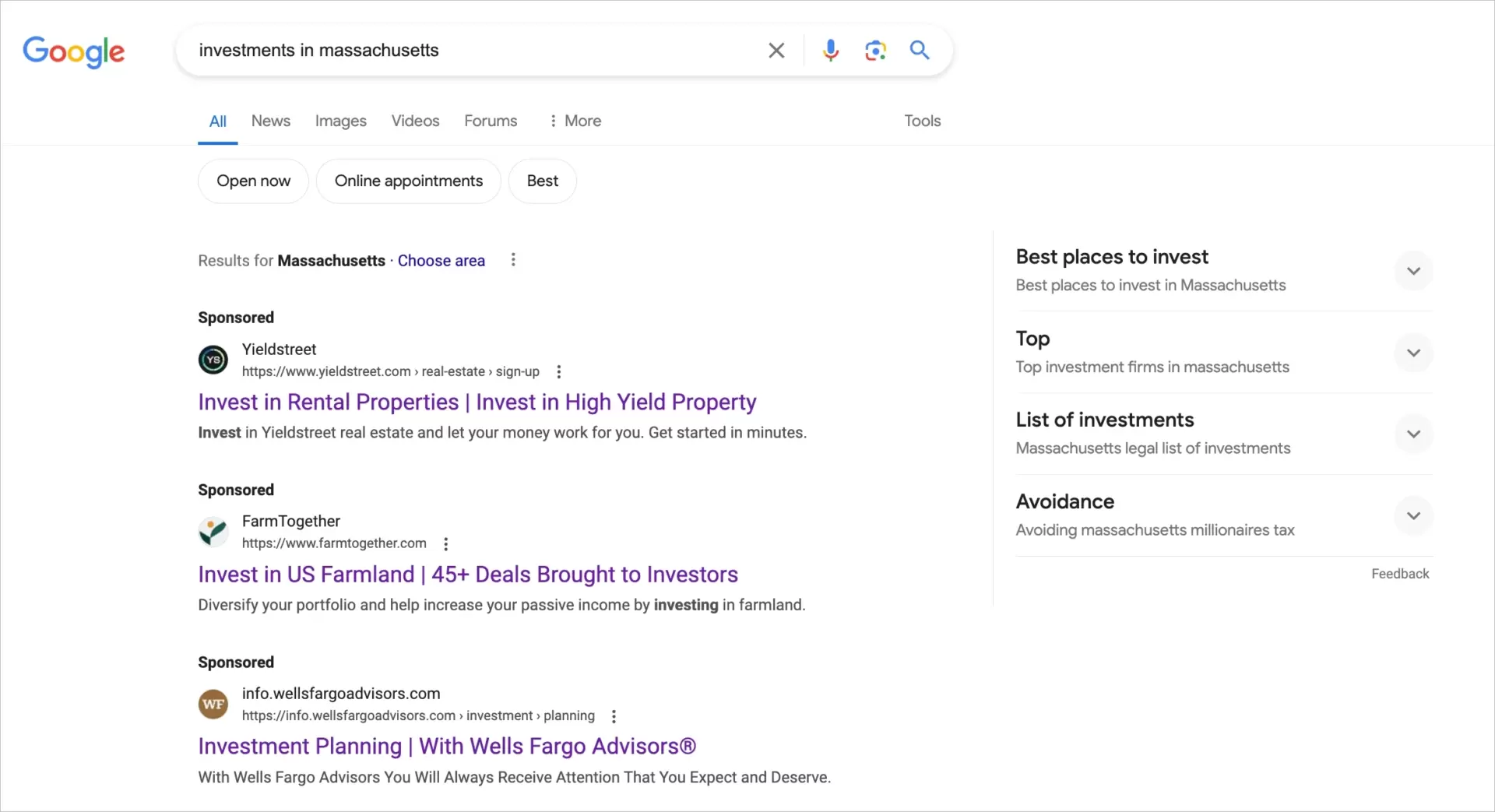
It’s a list of sponsored ads with winning positions for the phrase “investments in massachusetts”. The top one’s headline says, “Invest in Rental Properties | Invest in High Yield Property”. Once you click, you are immediately moved to the company’s (Yieldstreet) dedicated landing page, where you can start your journey in the platform and invest some money into properties in the region.
Strong point: Clear CTA standing out from the background caught users from the very beginning.
Weak spot: The top menu could be limited so as not to distract users.
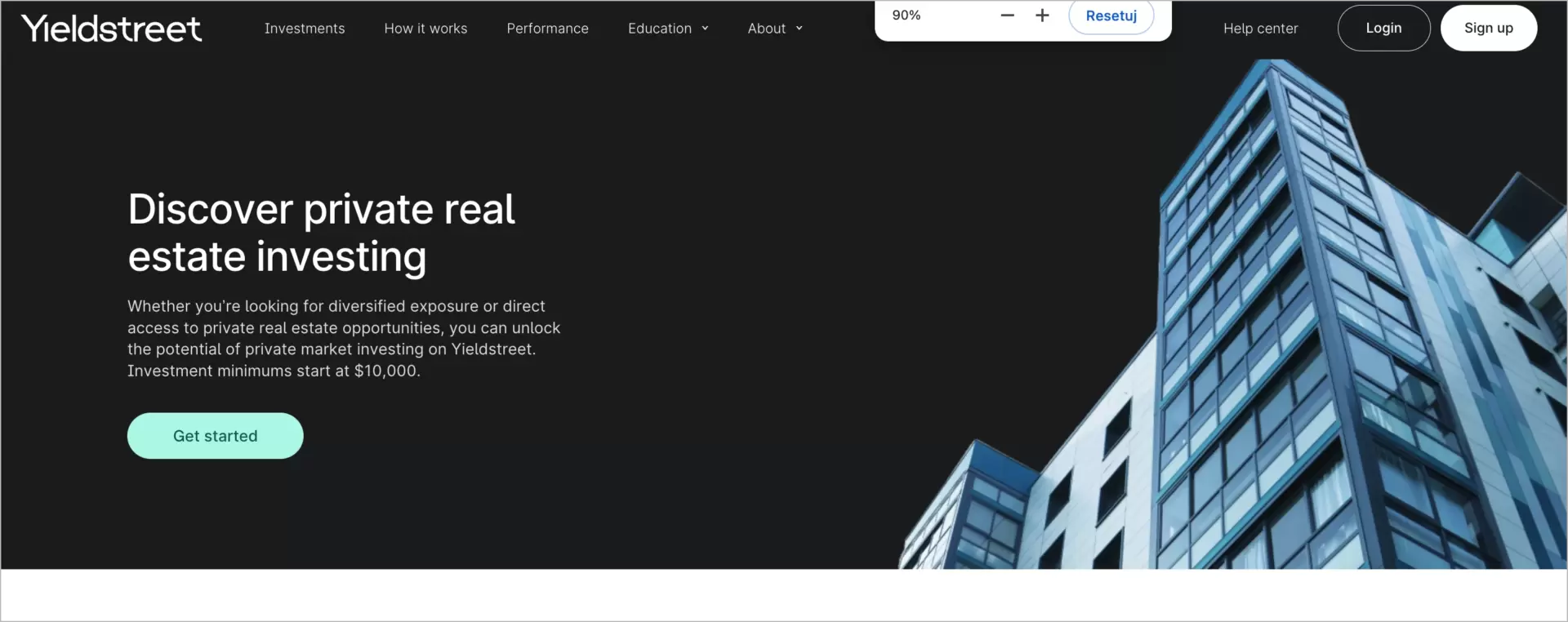
Source: https://www.yieldstreet.com/
Wanna build a landing page like the one above? Use the Business Consultant Landingi’s template.

2# CP Payments
CoinsPaid offers business crypto payment solutions. They focus is on display ads on social media, especially Facebook. Take a look at the example below.
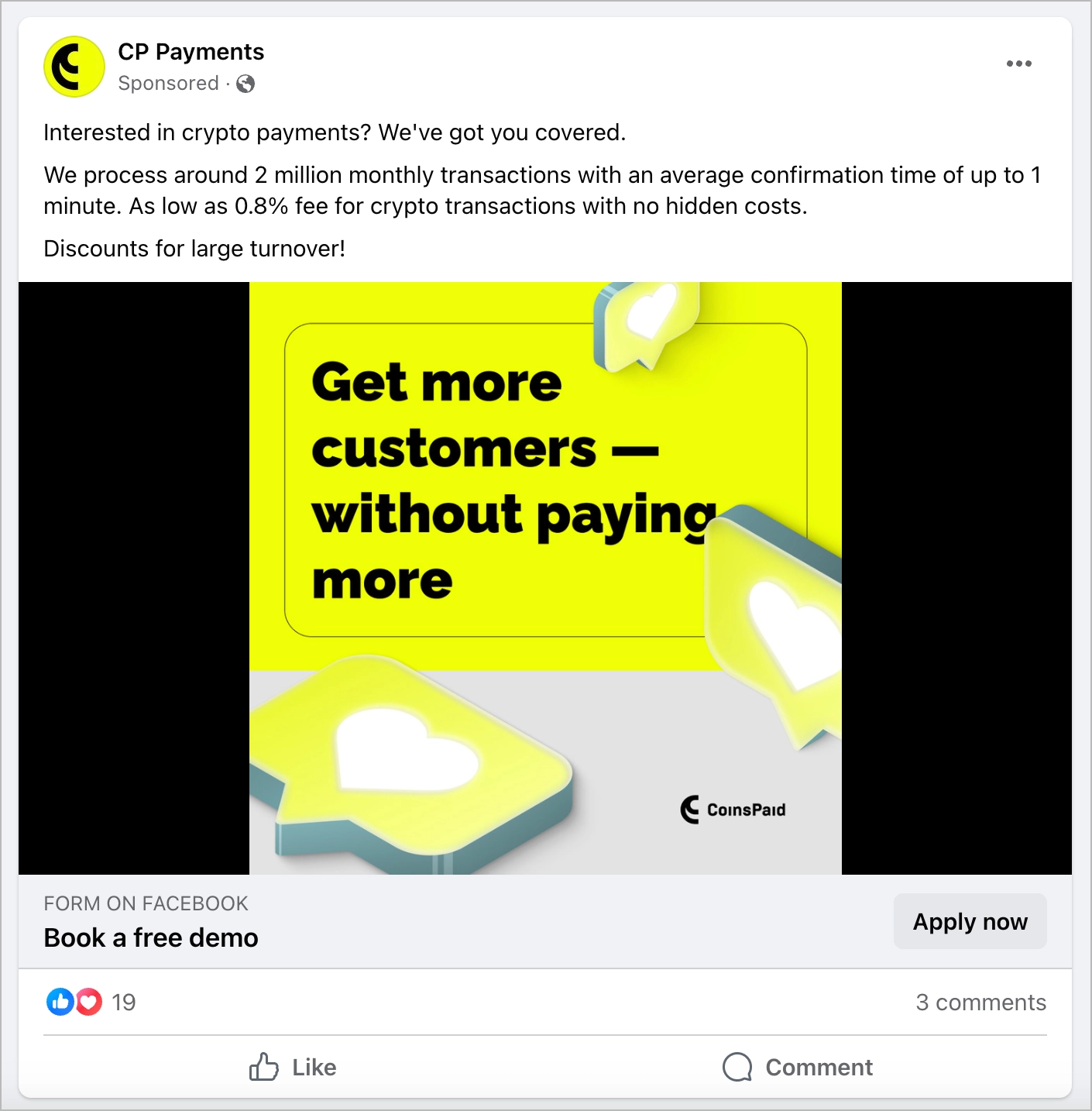
Strong point: A shining yellow background makes user won’t overlook the ad
Weak spot: The is no immediate connection between the product type and the headline copy.
#3 Qualtrics
Qualtrics is a company offering market research. They target, among others, business customers from Barcelona typing in the search box phrase: “market research Barcelona”:
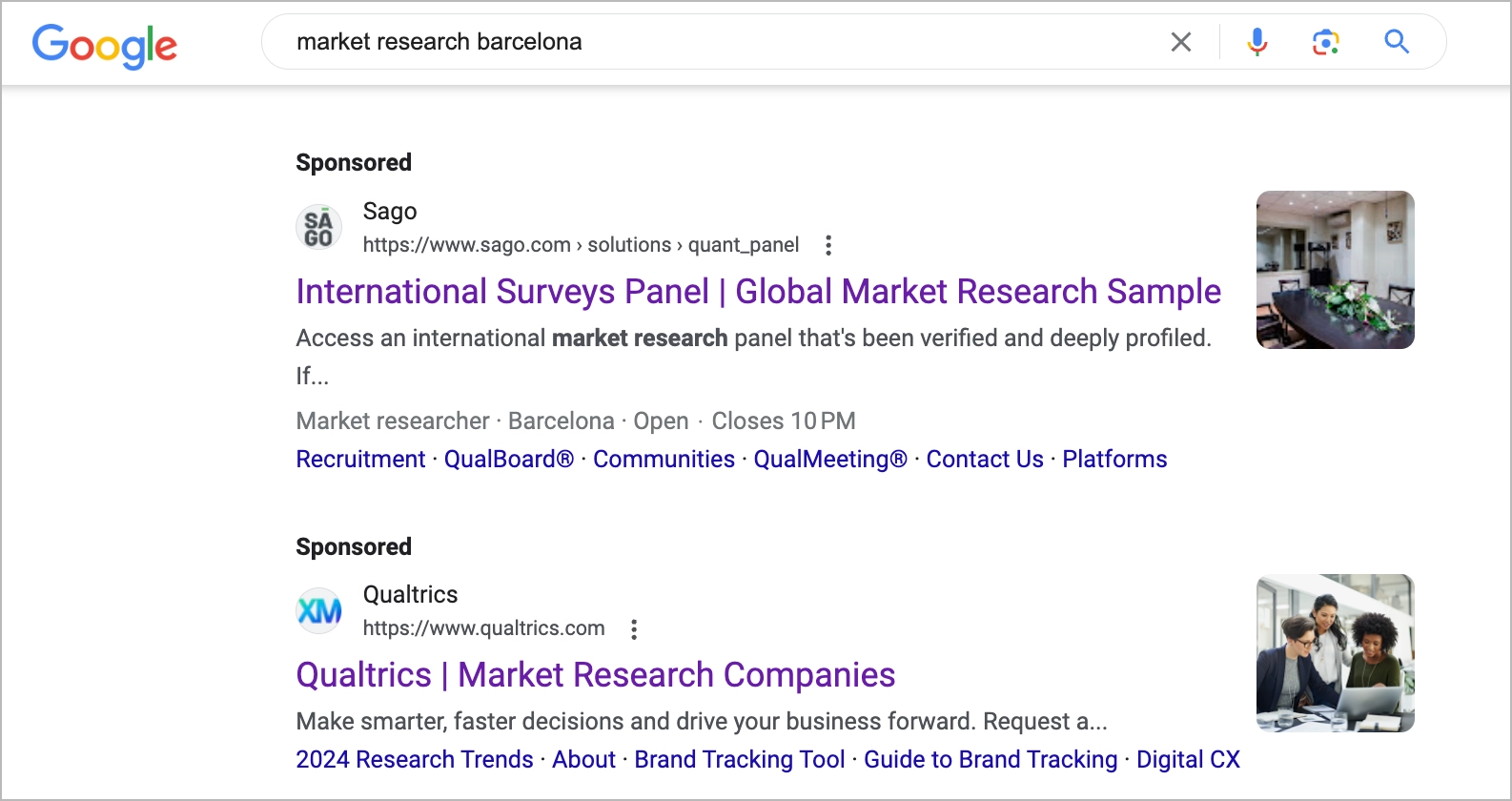
The landing page behind the ad includes a contact form and presents as follows:
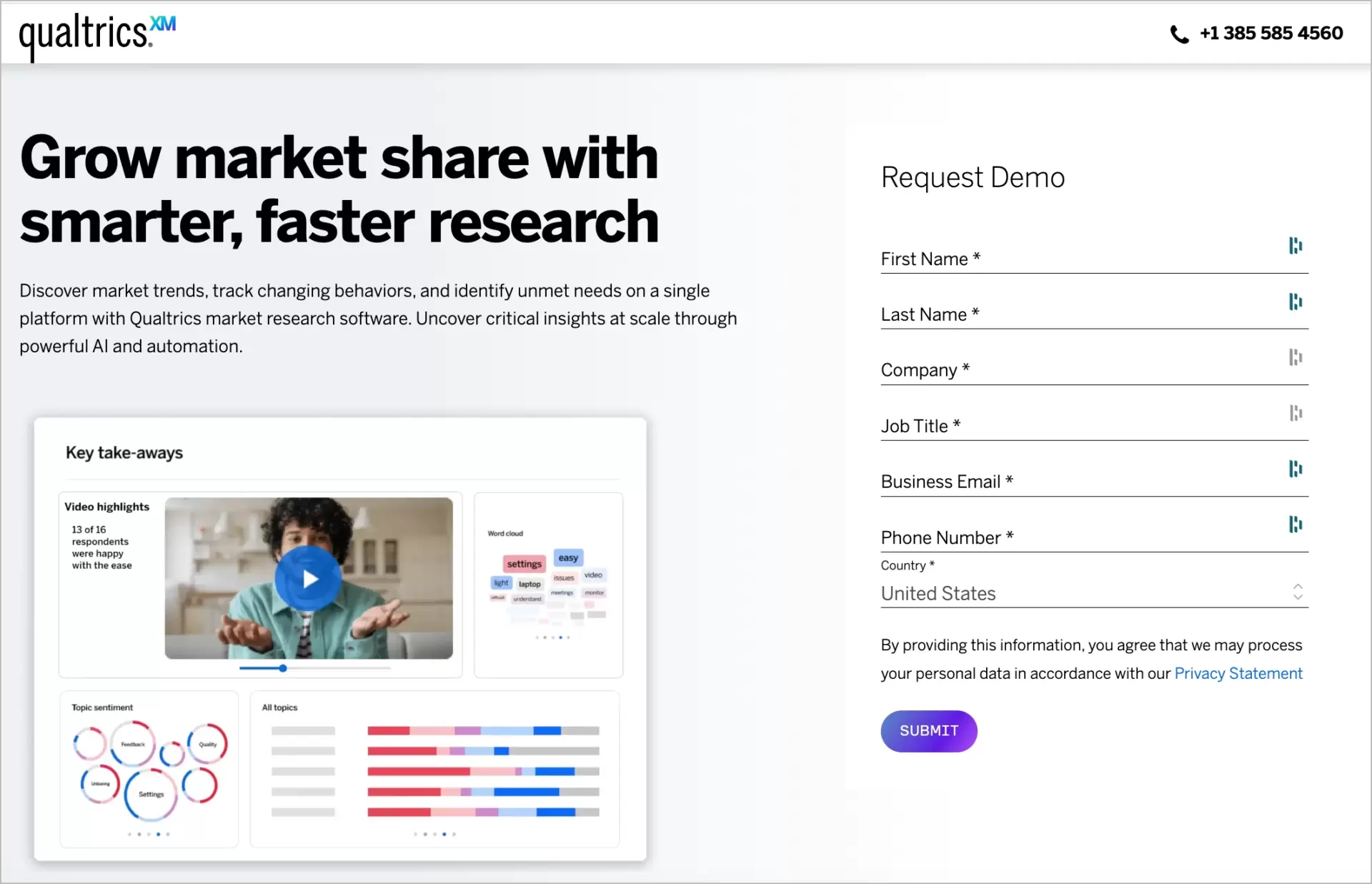
Strong point: No top menu means no distractions. Informational video, on the other hand, highlights product benefits.
Weak spot: The number of fields in the form should be reduced to make the process quick and straightforward for users.
If you are going to build a similar landing page, consider using Investment landing page template by Landingi.
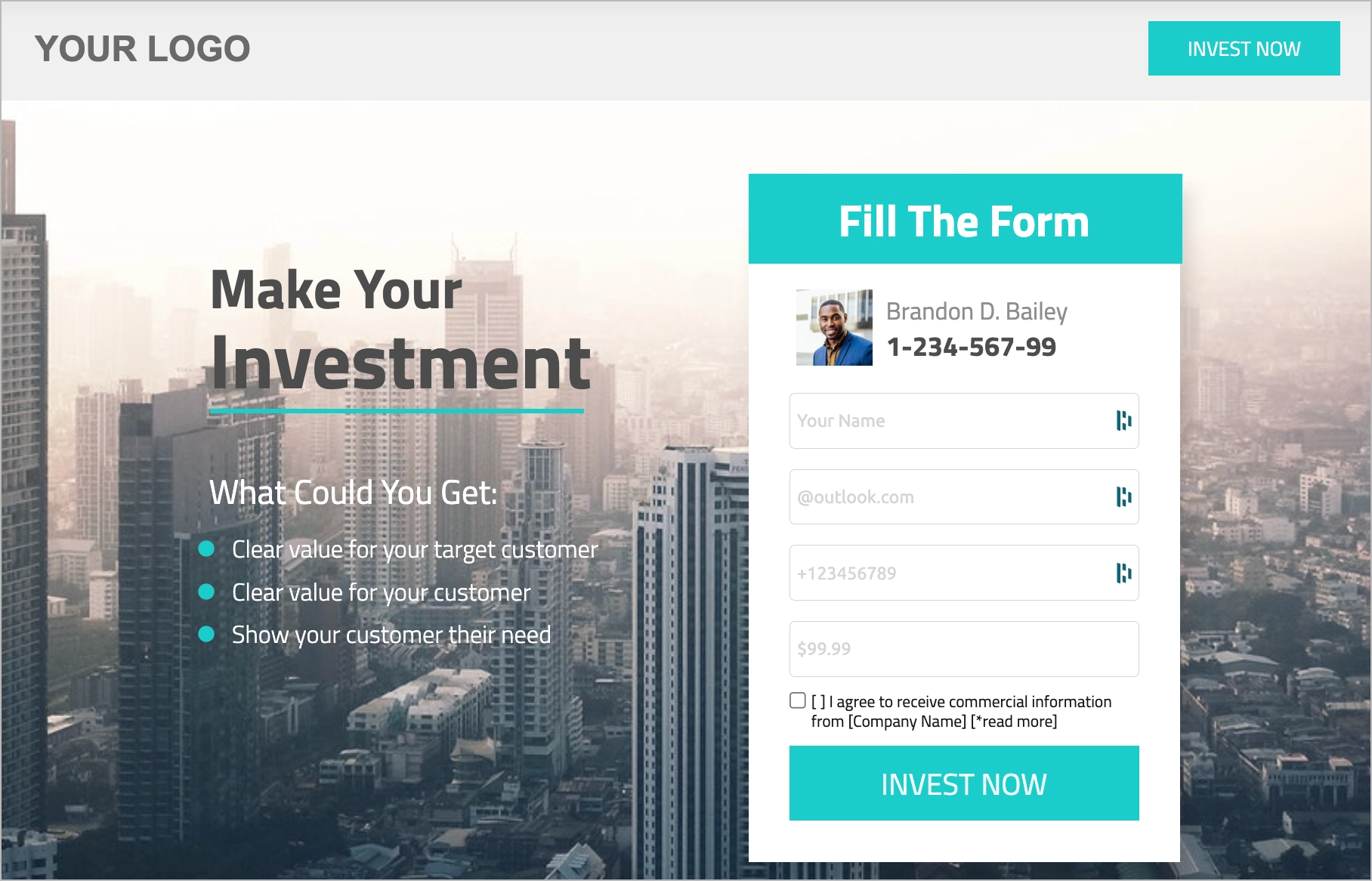
#4 Bench
While looking for a tax advisor in the New York area with Google, you may encounter the ad by Bench:
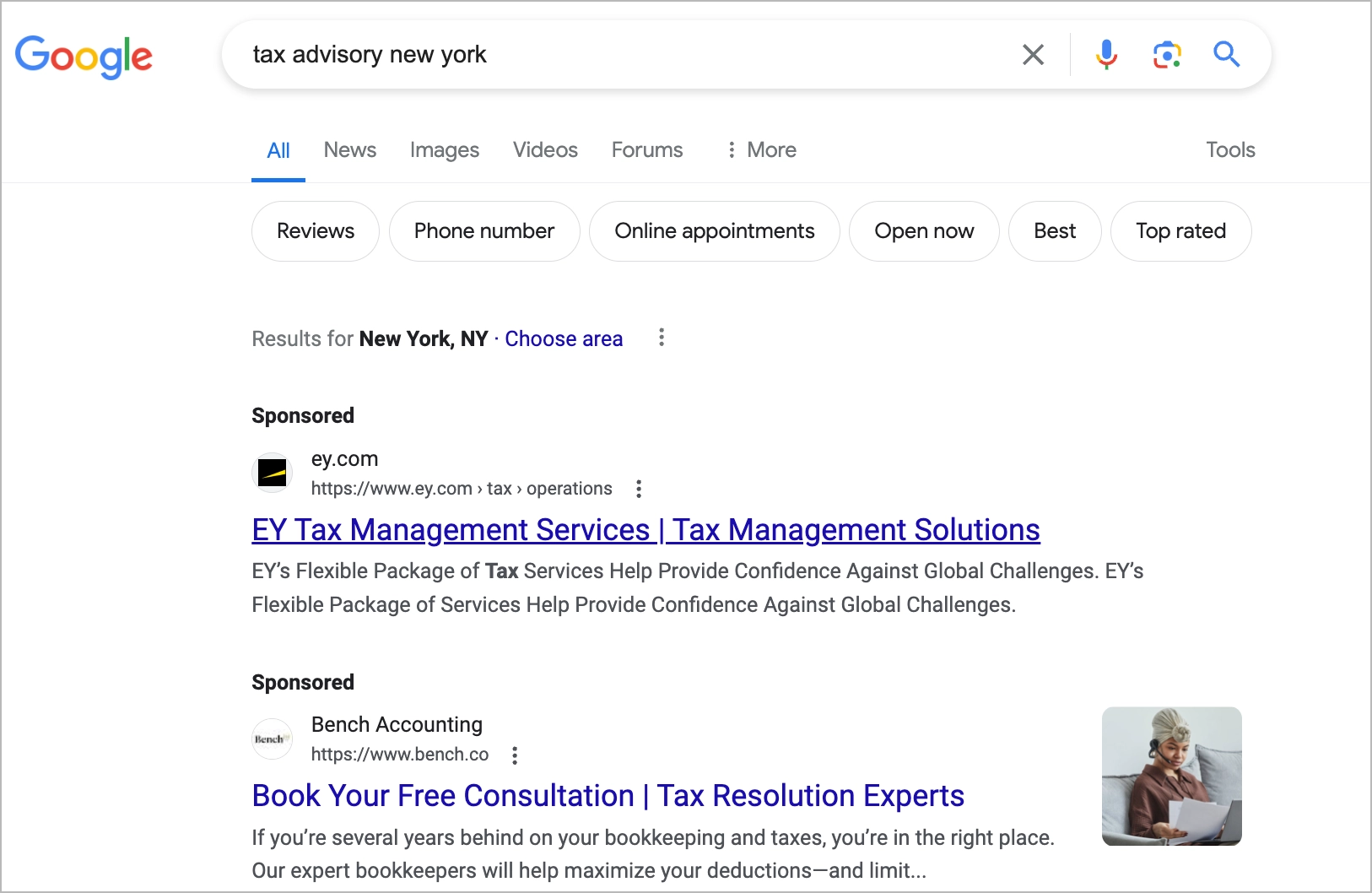
Ad is linked to their landing page, where you can book a free consultation:
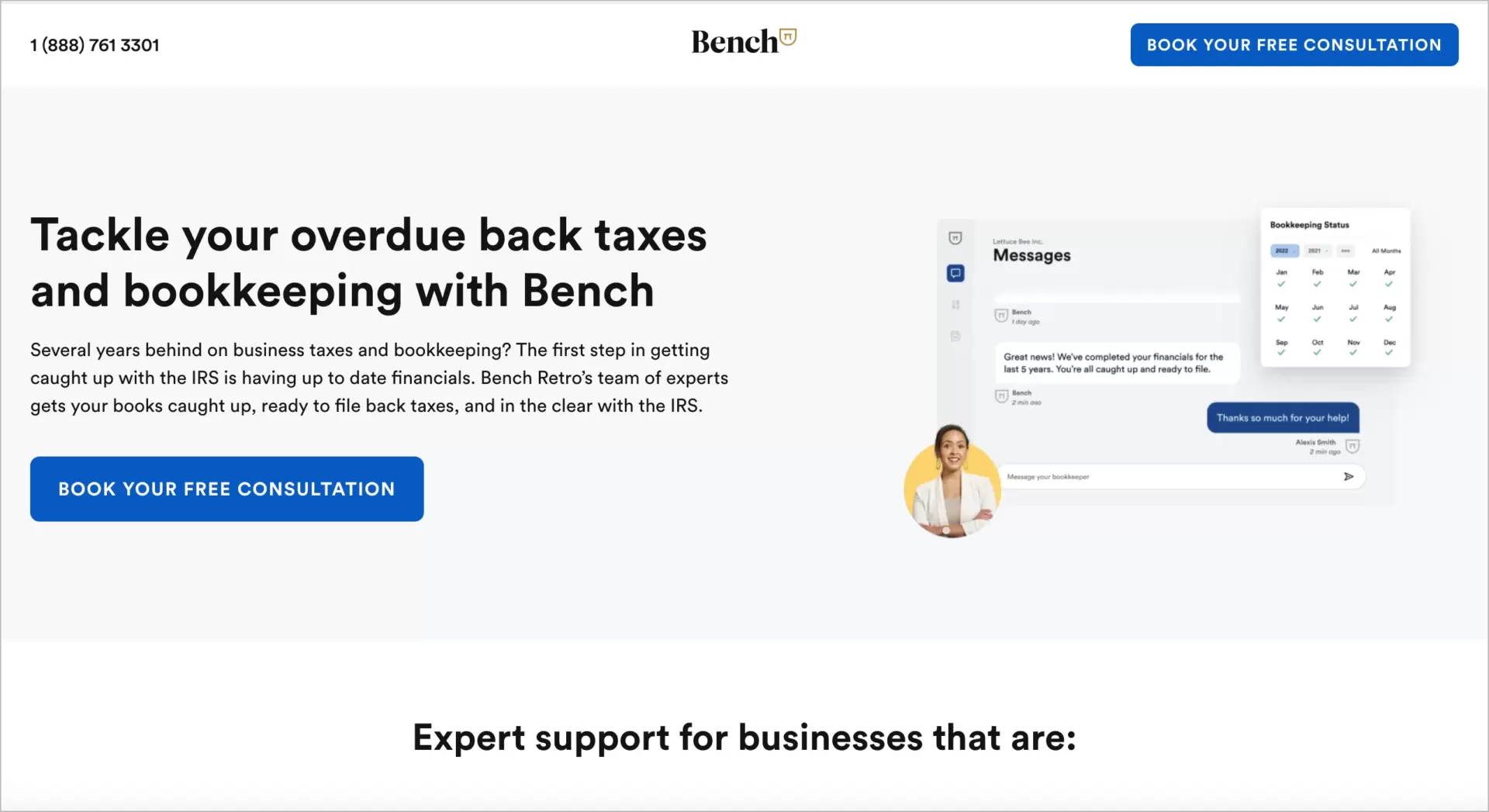
Source: https://www.bench.co/
Strong point: Well-exposed CTA – no room for confusion. A straigh way to conversion.
Weak spot: No unique value proposition of the product delivered at the user’s doorstep, nor the benefits clearly highlighted.
How to Measure the Success of Your Economics PPC Campaigns?
To measure the success of your economics PPC campaigns, you can use popular indexes like CTR, CR, ROAS, CPC, and custom solutions (for example, set in Google Analytics). Here is a handful of details for each option:
- Click-Through Rate (CTR) shows how many people clicked on your ad after seeing it. A high CTR means your ad is effective.
- Conversion Rate indicates how many clicks lead to a desired action, like a signup or purchase. A high conversion rate means your landing page is persuasive.
- Return on Ad Spend (ROAS) measures how much revenue you earn for every dollar spent on ads. It helps you understand your campaign’s profitability.
- Cost per Conversion tells you how much you spend to get one conversion. It helps you manage your budget effectively.
- User Behavior will let you see how visitors interact with your site after clicking your ad. Look at metrics like bounce rate and session duration to identify areas for improvement.
By tracking these metrics, you can gauge the performance of your PPC campaigns and make data-driven adjustments to improve results.
How to Track ROI and Conversion Rates in Economics PPC
To track ROI and conversion rates in your economics PPC campaigns, follow these steps:
- Set Up Conversion Tracking: Use tools like Google Ads Conversion Tracking or Google Analytics to monitor actions taken by users after clicking your ad. This includes form submissions, purchases, and other valuable actions.
- Calculate ROI: Compare the revenue generated from your ads to the cost of running them. Use the formula: ROI = (Revenue − Cost / Cost) × 100 to get a percentage indicating your profitability.
- Monitor Conversion Rates: Track how many clicks result in conversions. Calculate the conversion rate with: CR = (Conversions / Clicks) × 100. A high conversion rate means your ads and landing pages are effective.
- Use Analytics Tools: Leverage platforms like Google Analytics for detailed insights into user behavior, identifying which campaigns, ads, or keywords drive the most conversions and revenue.
What Are the Latest Trends in PPC Economics Marketing?
The latest trends in PPC economics marketing include AI automation, voice search optimization and advanced personalization. AI today is able to automate bidding strategies and optimize ad performance using real-time data. Voice search optimization helps PPC ads by targeting conversational phrases and long-tail keywords, making ads more relevant to the increasing number of voice search queries. Finally, enhancing ad experiences by personalizing content based on user behavior and preferences leads to higher engagement and conversions.
What Are Common Mistakes to Avoid in Economics PPC?
Common mistakes to avoid in economics PPC include neglecting keyword research, overlooking negative keywords, having poorly optimized landing pages, and failing to track conversions.
- Neglecting Keyword Research: not conducting thorough keyword research can lead to targeting irrelevant or overly competitive keywords, resulting in wasted ad spend and poor campaign performance.
- Overlooking Negative Keywords: failing to use negative keywords means your ads may appear for irrelevant searches, wasting budget on clicks that are unlikely to convert.
- Poorly Optimized Landing Pages: sending traffic to poorly optimized landing pages with slow load times, unclear messaging, or difficult navigation can result in high bounce rates and low conversions.
- Failing to Track Conversions: without tracking conversions, you won’t have the data needed to measure your campaign’s success or make informed adjustments, leading to inefficient use of your budget and missed opportunities for optimization.
By avoiding these mistakes, you can improve the effectiveness and efficiency of your economics PPC campaigns.
How to Choose the Right PPC Agency for Your Economics Business?
To choose the right PPC agency for your economics business, focus on their expertise, track record, industry understanding, and communication style. Look for an agency experienced in PPC campaigns, particularly in the economics sector, and familiar with the latest advertising trends. Evaluate their success through client testimonials and case studies. Ensure they have a solid grasp of the economics industry, including its terminology and target audience. Finally, choose an agency that communicates clearly, offers transparent reporting, and collaborates closely with you to achieve your business goals.
How to Collect Leads from PPC Economics Campaigns?
To collect leads from PPC economics campaigns, create compelling landing pages, use strong calls-to-action, and employ lead capture forms.
Design landing pages that are highly relevant to your brand, providing clear and valuable information. List the benefits of your products and emphasize advantages over your competitors. Remember to keep the tone of voice that resonates with your audience. You may streamline the content creation process by leveraging AI generators. In Landingi, AI tools for this purpose are integrated into the platform.
Use strong calls-to-action (CTAs) that encourage visitors to take the next step, such as “Download Now” or “Get Your Free Report”. Incorporate lead capture forms to collect essential information like name, email, and company.
Additionally, consider offering valuable incentives, such as eBooks, whitepapers, or free consultations, to entice users to provide their contact details. Regularly optimize and test your landing pages and forms to improve their effectiveness in capturing leads.
Next Steps to Elevate Your Economics PPC Efforts
If you’re ready to put what you’ve learned into action, picking the right landing page builder is essential. Remember, landing pages are critical as they’re where conversions ultimately occur. Make sure the tool you choose integrates seamlessly with the ad platforms you are using (some popular limit integrations to selected systems). Opt for platforms offering templates specifically designed for your industry, which can significantly speed up the development process. The following are also must-have features:
- Extensive customization options to align your pages with your brand and captivate visitors through striking designs.
- AI-powered content generation tools to efficiently create targeted content, saving time and costs.
- Analytics and conversion tools, crucial for data-driven optimization of landing pages to identify and alleviate user pain points, enhancing conversion rates.
All these features are part of Landingi, widely recognized by digital marketing professionals as a leading force in PPC landing page creation. Start your free trial now and join esteemed companies like Sony, Opera, and Nationale Nederlanden, all of whom rely on it for its reliability and proven performance.

